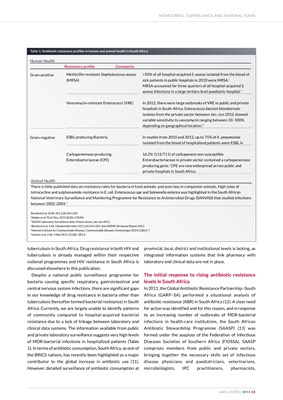
tuberculosis in South Africa. Drug resistance in both HIV and
tuberculosis is already managed within their respective
national programmes and HIV resistance in South Africa is
discussed elsewhere in this publication.
Despite a national public surveillance programme for
bacteria causing specific respiratory, gastrointestinal and
central nervous system infections, there are significant gaps
in our knowledge of drug resistance in bacteria other than
tuberculosis (hereafter termed bacterial resistance) in South
Africa. Currently, we are largely unable to identify patterns
of community compared to hospital-acquired bacterial
resistance due to a lack of linkage between laboratory and
clinical data systems. The information available from public
and private laboratory surveillance suggests very high levels
of MDR-bacterial infections in hospitalized patients (Table
1). In terms of antibiotic consumption, South Africa, as one of
the BRICS nations, has recently been highlighted as a major
contributor to the global increase in antibiotic use (11).
However, detailed surveillance of antibiotic consumption at
provincial, local, district and institutional levels is lacking, as
integrated information systems that link pharmacy with
laboratory and clinical data are not in place.
The initial response to rising antibiotic resistance
levels in South Africa
In 2011, the Global Antibiotic Resistance Partnership-South
Africa (GARP-SA) performed a situational analysis of
antibiotic resistance (ABR) in South Africa (12). A clear need
for action was identified and for this reason, and in response
to an increasing number of outbreaks of MDR-bacterial
infections in health-care institutions, the South African
Antibiotic Stewardship Programme (SAASP) (13) was
formed under the auspices of the Federation of Infectious
Diseases Societies of Southern Africa (FIDSSA). SAASP
comprises members from public and private sectors,
bringing together the necessary skills set of infectious
disease physicians and paediatricians, veterinarians,
microbiologists, IPC practitioners, pharmacists,
MONITORING, SURVEILLANCE AND NATIONAL PLANS
AMR CONTROL 2015 55
Table 1: Antibiotic resistance profiles in human and animal health in South Africa
Human Health
Resistance profile Comments
Animal Health
There is little published data on resistance rates for bacteria in food animals, and even less in companion animals. High rates of
tetracycline and sulphonamide resistance in E. coli, Enterococcus spp and Salmonella enterica was highlighted in the South African
National Veterinary Surveillance and Monitoring Programme for Resistance to Antimicrobial Drugs (SANVAD) that studied infections
between 2002-2004.vi
Gram-positive
Gram-negative
Methicillin-resistant Staphylococcus aureus
(MRSA)
Vancomycin-resistant Enterococci (VRE)
ESBL-producing Bacteria
Carbapenemase-producing
Enterobacteriaceae (CPE)
>50% of all hospital-acquired S. aureus isolated from the blood of
sick patients in public hospitals in 2010 were MRSA.i
MRSA accounted for three quarters of all hospital-acquired S.
aureus infections in a large tertiary level paediatric hospital.ii
In 2012, there were large outbreaks of VRE in public and private
hospitals in South Africa. Enterococcus faecium bloodstream
isolates from the private sector between Jan-Jun 2012 showed
variable sensitivity to vancomycin ranging between 33-100%
depending on geographical location.
iii
In studies from 2010 and 2012, up to 75% of K. pneumoniae
isolated from the blood of hospitalised patients were esbl.iv
16.2% (115/711) of carbapenem non-susceptible
Enterobacteriaceae in private sector contained a carbapenemase
producing gene.
v CPE are now widespread across public and
private hospitals in South Africa
i
Bamford et al. SAJEI 2011;26:243-250
ii
Naidoo et al. PLoS One. 2013 8(10): e78396
iii
SASCM Laboratory Surveillance data, Private Sector, Jan-Jun 2012
ivBamford et al. S Afr J Epidemiol& Infect 2011;26:243-250. And GERMS-SA Annual Report 2012
vNational Institute for Communicable Diseases. Communicable Diseases Communiqué 2014;13(8):6-7
vi
Henton et al. S Afr J Med 2011;101(8): 583-6